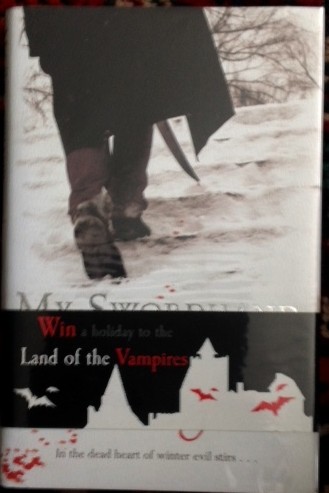Inspiring Young Readers
 posted on 23 Aug 2021
posted on 23 Aug 2021
My Swordhand Is Singing by Marcus Sedgwick
The vampire legend tends to be dominated by the conventions established by Bram Stoker’s Dracula but, as Marcus Sedgwick points out in an informative addendum at the end of his tale, the vampire myth is in fact a richer and much more diverse one than hinted at by Stoker.
My Swordhand Is Singing cashes in on some of these less well-known features of the vampire story and that makes it a much richer experience – and one which for the teenage reader will offer genuine thrills and just about the right blend of terror and suppressed eroticism.
The scene is somewhere in Eastern Europe in the 17th century when we meet Peter and his father who have settled briefly from their itinerant life on the edges of a small village called Chust. They make a living cutting and selling wood taken from the local forest and although they make just enough to get by on, the town has never really accepted them. Peter has found himself having to do most of the business because of his father’s increasing misanthropy and his obvious drink problem.
The only good things in Peter’s life are his stolid and faithful horse and his love for one of the village girls, Agnes. But Peter knows all is not well and that there are things bubbling away under the surface that are going to involve him and which aren’t going to be good. There’s a vibe in the air and it means nobody no good.
The arrival of a band of Gypsies seems to be the catalyst that kick-starts a chain of events that will bring Peter face-to-face with the living dead. He will also discover his father’s secret history, the reason for his refusal to mix with other people and just what lies in the long wooden box that his father never lets out of his sight.
This is an absolute must for a young adult who loves fast moving excitement and thrilling action that doesn’t patronise or compromise. The book is also full of big ideas, adult themes and brings a different perspective to the vampire story that doesn’t romanticise or invade the territory carved out by Stephanie Meyer’s Twilight series. Other, better judges than me seem to have agreed with this assessment because it won the 2007 Booktrust Teenage Prize and was also shortlisted for the CILIP Carnegie Medal in 2007.
I loved the first two-thirds of this book but I felt towards the end, as the big battle with the undead unfolds, Sedgwick rather loses control of the narrative and it all becomes a bit too comic-book for my taste. There’s a helter-skelter pace to the ending which sits as something of a contrast with the careful accretion of details that has preceded it. I couldn’t help but feel that the author had been given (or had given himself) a limit on the length of the book which he felt he couldn’t breech. The book, I think, deserved a more thoughtfully rounded end rather than an almost slapstick action sequence that made me feel that the Benny Hill theme tune was playing somewhere in the background.
Despite this rather clumsy conclusion I would still heartily recommend this for teenage readers – it’s smart and savvy and there’s a sequel to pick up Peter’s later adventures.
Terry Potter
August 2021